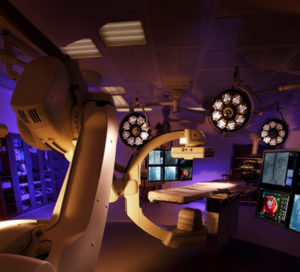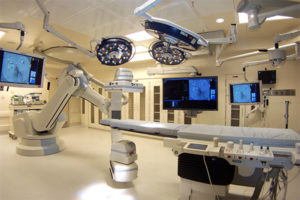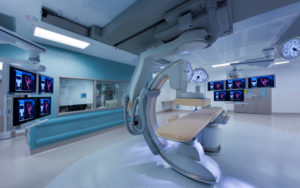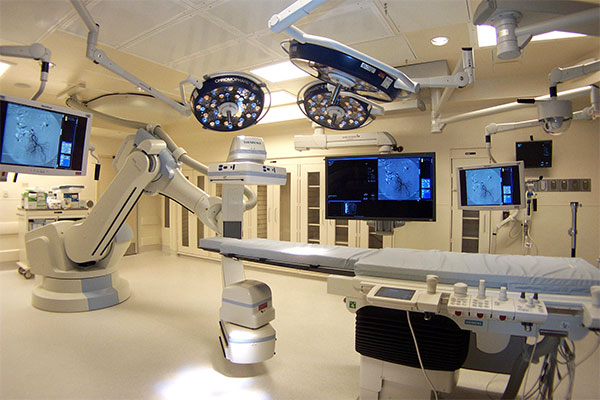Operational, design parameters + visualizing space = collaboration
Hybrid ORs—high-tech surgical suites that feature advanced imaging and robot-assisted/led surgery devices—have facilitated incredible advancements in surgery, providing patients the opportunity for less invasive traumatic surgery and resulting in more rapid recovery. Complex cardiovascular and endovascular procedures that used to require open heart surgery are now being diagnosed and treated in hybrid ORs.
In addition to enabling advanced surgeries and improving care delivery, these hybrid ORs are becoming an important part of attracting and retaining top-tier surgical talent. Health systems focused on recruiting innovative surgeons know it is imperative to provide leading-edge facilities. These advanced surgical theaters, however, can present complex engineering, design and construction challenges. The advanced technology that needs to work seamlessly, combined with designing a space that also functions as a true OR, requires smart planning and smart design. It also involves planning for flexibility and special requirements.
Operational and design parameters

Create an open dialogue with stakeholders to better understand their current processes and needs, as well as determine future requirements. Since hybrid ORs can accommodate more image-driven surgeries, oftentimes the procedures will be new. Consequently, the team must also work with stakeholders to determine how their new strategy for approaching a case is supported by the space. Additionally, the design should be operationally efficient. Therefore, designers must determine how to create hybrid ORs that also support more traditional surgery practices, which carries with it a substantial business benefit. If case load is light, for example, a hybrid OR can function as a traditional operating theater to maximize utilization. Another key factor is a flexible design that allows physicians to make a quick shift to a more invasive procedure protocol during surgery in the event of emergency. Designers must find solutions for how to build in this flexibility and operability in granular detail—even down to the utility-cart level.
Designers need to evaluate and ensure the potential site is viable. Often, hospitals have space they would like to convert to a hybrid OR, but designers must confirm it will work with the facility manager and with the team of engineers from operational and structural perspectives to determine if the space can accommodate the special requirements of a hybrid OR, including heavy equipment and interconnected technology. For instance, can the ceiling support the weight of a ceiling-mounted surgical arm? Through dialogue with stakeholders and the site assessment, the team is able to set operational parameters.
The designer explores operational questions with stakeholders, evaluating if the space will work with the existing departments, and how a room could be set up for various types of procedures. Designers also work with stakeholders to establish if the suggested site supports operational adjacencies and optimizes flow. Successful hybrid OR design does not simply add technological capabilities to a hospital, but it ensures the OR theater works within the facility and is sited appropriately; i.e., does it make sense from a space planning standpoint?
Visualizing the options

Plan for the special requirements and visualize the space. At this point, the design team begins working with vendors and modeling the room, populating the models with various technology, such as booms and monitors. Continue asking the functional questions of how a space can accommodate the technology. Not fully understanding installation requirements is a costly potential pitfall of hybrid OR design, and designers must be vigilant about getting installation requirements from vendors, which often impact the design and engineering.
The design team and engineers continue evaluating how selections might impact ductwork, flooring and other physical, structural elements, as well as the operational impacts. In terms of operational efficiency, one type of equipment could be a better choice to create a more flexible space that can be turned over quickly and used for traditional surgeries. From a structural standpoint, one type of surgical arm may be ceiling-mounted while another can be placed on the floor. At first, a ceiling-mounted system might seem more complex to install and the floor unit is chosen as the presumably cheaper alternative. However, if the vendor did not disclose that the floor unit requires additional or special flooring, it adds cost later in the process in terms of additional structural considerations, materials and construction. Designers and engineers must work through these considerations with the facility manager to sell in the best solution to stakeholders.
The model created at this stage is important to help all stakeholders understand how the room could function. It also aids in equipment choices, and in making changes to the design to optimize the room. Technology such as virtual reality has made these models even more powerful so that stakeholders can effectively experience the room before plans are finalized and construction begins.

The technology in hybrid ORs is sophisticated and requires precise installation and effective integration. Therefore, hybrid ORs require smart design, strong technical support, continued dialogue and a contractor that can interpret and bring to life this complex space.
Photos courtesy of Gresham, Smith and Partners.




